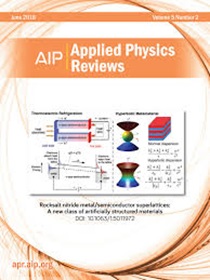Tetrafluorinated ionic organic terahertz crystals
IF 11.6
1区 物理与天体物理
Q1 PHYSICS, APPLIED
引用次数: 0
Abstract
Developing new organic crystals for efficient broad terahertz (THz) wave generation remains challenging, as multiple critical material properties must be achieved simultaneously within a single crystal. In this work, we introduce a new series of organic nonlinear optical salt crystals tailored for THz wave generators. The newly designed fluorinated cationic chromophore, 6-fluoro-2-(4-hydroxystyryl)-1-methylquinolinium (OH6FQ), has been incorporated with various fluorinated or non-fluorinated anions into six different ionic crystals. Notably, the tetrafluorinated crystals, composed of fluorinated OH6FQ cations and trifluorinated anions, meet essential requirements for efficient THz wave generation, including large macroscopic optical nonlinearity, optimal facet orientation in as-grown crystals with mm-size, plate-like morphology, and relatively low THz absorption across both the entire-molecular phonon and anion-stretching vibration regions. These tetrafluorinated crystals exhibit over 20 times higher optical-to-THz amplitude conversion efficiency compared to inorganic ZnTe, with a broad bandwidth extending up to 16 THz. To the best of our knowledge, this is the first report of tetrafluorinated ionic organic THz crystals, showing promising potential for diverse THz photonic and nonlinear optical applications.四氟化离子有机太赫兹晶体
开发新的有机晶体用于有效的宽太赫兹(THz)波产生仍然具有挑战性,因为必须在单晶中同时实现多种关键材料特性。在这项工作中,我们介绍了为太赫兹波发生器量身定制的一系列新的有机非线性光学盐晶体。新设计的氟化阳离子发色团,6-氟-2-(4-羟基苯乙烯基)-1-甲基喹啉(OH6FQ),已与各种氟化或非氟化阴离子结合成六种不同的离子晶体。值得注意的是,由氟化OH6FQ阳离子和三氟化阴离子组成的四氟化晶体满足高效产生太赫兹波的基本要求,包括大的宏观光学非线性,mm尺寸的生长晶体的最佳面取向,片状形态,以及在整个分子声子和阴离子拉伸振动区域中相对较低的太赫兹吸收。与无机ZnTe相比,这些四氟化晶体的光-太赫兹幅度转换效率高出20倍以上,带宽可达16太赫兹。据我们所知,这是四氟化离子有机太赫兹晶体的第一份报告,显示出各种太赫兹光子和非线性光学应用的良好潜力。
本文章由计算机程序翻译,如有差异,请以英文原文为准。
求助全文
约1分钟内获得全文
求助全文
来源期刊

Applied physics reviews
PHYSICS, APPLIED-
CiteScore
22.50
自引率
2.00%
发文量
113
审稿时长
2 months
期刊介绍:
Applied Physics Reviews (APR) is a journal featuring articles on critical topics in experimental or theoretical research in applied physics and applications of physics to other scientific and engineering branches. The publication includes two main types of articles:
Original Research: These articles report on high-quality, novel research studies that are of significant interest to the applied physics community.
Reviews: Review articles in APR can either be authoritative and comprehensive assessments of established areas of applied physics or short, timely reviews of recent advances in established fields or emerging areas of applied physics.
 求助内容:
求助内容: 应助结果提醒方式:
应助结果提醒方式:


